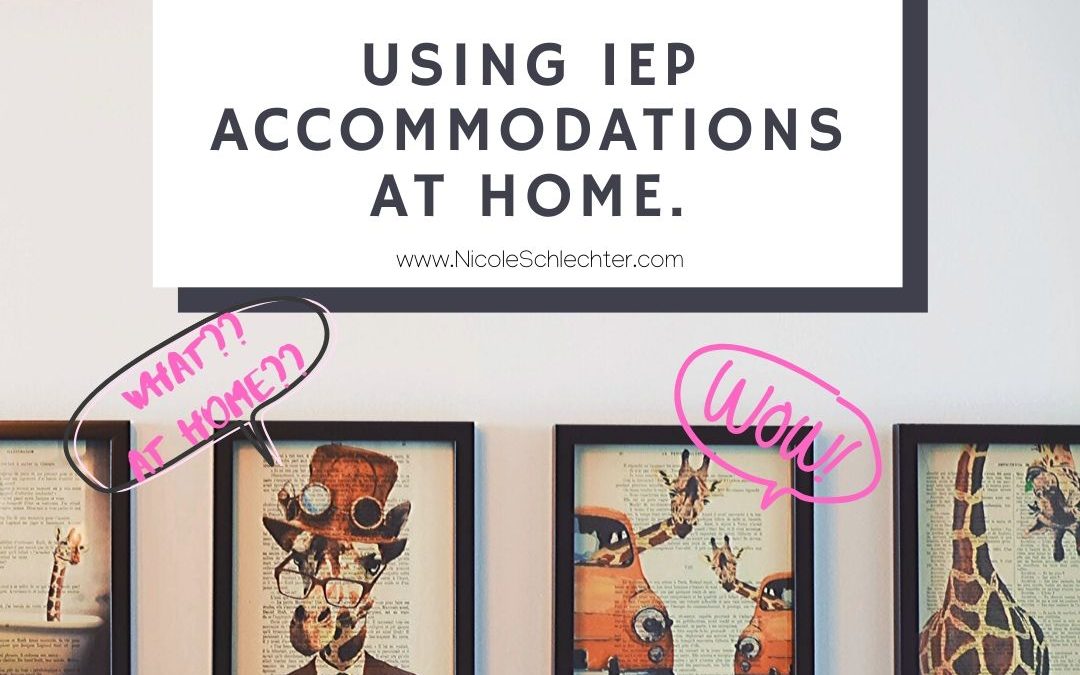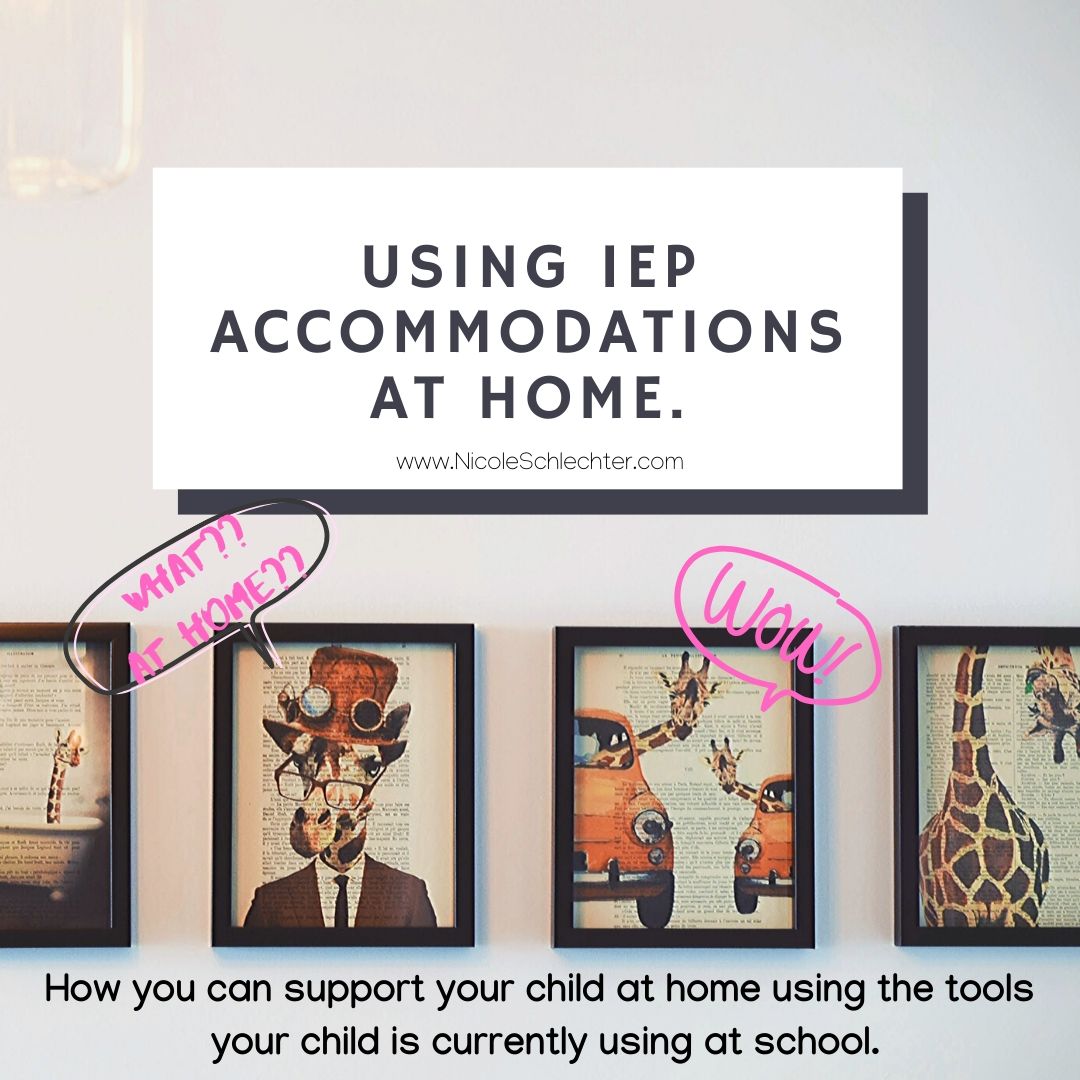I realize this sounds completely crazy, but stick with me, it’s worth it. I mean you don’t run a classroom, you aren’t a school. You aren’t a social worker or a speech therapist. You do not have an IEP at home… I get it. BUT what if you could make everyone’s life a little easier, what if your child could begin to make progress quicker just by using the IEP accommodations at home? This is absolutely possible, and I’m going to tell you how.
One of the most common questions I get when supporting a family through special education is but what about at home? There is no rule book, no class you can take and the blog posts claiming to have all the answers are EVERYWHERE, so how are you supposed to figure this out on your own? The answer, you’re not. You aren’t supposed to do this alone. They say it takes a village for a reason. You are struggling at home with behavior, anxious feelings, changes in routine, changes in expectations. So why not keep the expectations the same as at school?
When I sit in meetings for families one of the things I stress to the team is the importance of consistency across all environments. When our expectations stay the same from home to school and school to home, our kiddos KNOW what they are supposed to do. And when they know what is expected, they are able to make more progress more quickly. This could include the behavior intervention plan, the behavior chart hung up in the classroom, a visual schedule, a communication system… See where I’m going with this?
Quick. Pull out your childs IEP. Flip through to accommodations. Now pause to think of the most difficult part of your childs day at home. Is it getting ready in the morning? Is it bedtime? Homework time? Maybe just the weekends are a struggle. Look back at those IEP Accommodations. How can you apply those same tools to home?
Let’s look at some examples:
Flexible seating.
What that looks like at home? The opportunity to move around as they work. Sitting on a ball instead of a chair, the choice to sit in a bean bag during homework time. Ask the team what kind of options your child is choosing at school and find a way to duplicate this option at home. Maybe its a stool, or doing homework standing at the counter. We aren’t trying to reinvent the wheel, use what is already working.
Visual Schedule.
What does that look like at home? Posted schedules of routines throughout the house. A checklist in the bathroom of expectations for example. Brush your teeth, put the lid back on the toothpaste and place in cabinet. A checklist in their bedroom before they go downstairs. Get dressed, new clothes, new underwear, place pajamas in laundry basket, brush teeth, wash face, bring chromebook downstairs. This can be as specific as you need it.
Provide classroom job.
What does this look like at home? This could be part of a reward chart or it could be structured “duties” throughout the day. JD you are so good at matching the socks, can you be my helper while I do laundry? JD I really need some help making dinner, can you be my assistant chef and place the utensils on the table? Giving them a job makes them feel important and needed but also structures their time in a way that they can succeed. Ask the team what types of “jobs” your child likes to do at school. Maybe it’s delivering papers to another teacher and at home, they could get the mail or bring clutter upstairs to be put away.
Alternative test taking/ frequent breaks.
What does this look like at home? Provide a designated work space just for homework. This can be a quiet area of the kitchen away from distractions. Give your child a timer or a schedule of when breaks will happen and how long they will be. Give them an option of what those breaks entail… just like at school. Ask the team what this looks like at school so you can duplicate the breaks at home.
Check in Check out.
What does this look like at home? I LOVE using this tool when I know my kiddo is really struggling to follow expectations at school or there is a change in routine. I ask the team to supply a schedule for the day. We discuss it before school and go through what the day may look like. Then we go back over it after school with LOTS of positive praise for all the areas they did well.
Cues of expected behavior.
What does that look like at home? I’m sure you are already doing this, BUT ask the team what kind of words they use. Use the same language that they use at school. “Kind words please.” “Safe body please.” Avoid using words like STOP or Don’t do that. Instead replace those words with actionable phrases. Kind words is a reminder of what the expectation is rather than focusing on the negative action.
The IEP may be a school document, but staying consistent across environments will help your child succeed throughout their day. When they feel like they are winning, they feel good about themselves, and when they are in a good place, they are more likely to be able to meet more goals.
At your next IEP meeting, ask the team to support you in the goal of using these accommodations at home. How can you be more consistent in multiple environments? This is a positive way to collaborate with your team! This type of collaboration goes both ways. If something is working well at home, share it with the team also. It’s helpful for the team to use what is already working rather than start from scratch.


